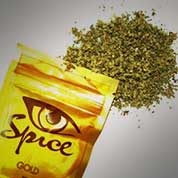Synthetic Cannabinoids (Spice, K2)

Overview
These are man-made (synthetic) chemicals that aim to copy the effects of the main active ingredient of cannabis, THC. These chemicals are usually sprayed on to plant material or natural herbs (which do not normally contain any tobacco or cannabis).
Some of these substances are now controlled under the Misuse of Drugs Act, but most are still not covered by this legislation. Ones that are not controlled are subject to the Medicines Act, so labels will often say ‘not for human consumption’.
See ‘Research Chemicals’ section for more details.
Sometimes the effects are stronger than typical cannabis. Also, as these are new chemicals, there may some compounds where no information of its effects, including adverse effects, exists. The detectability of the compounds in standard drug tests is a subject of conjecture. New tests are being developed that will detect most synthetic cannabinoids.
- Happy and relaxed (in moderate doses)
- Synesthetic (one type of stimulation evokes the sensation of another sense) effects
- Drowsiness
- Problems with co-ordination
- Paranoia and forgetfulness is possible but not known whether it exists for all these chemicals
- Dose/potency concerns
In its pure form, it comes as a solid or oil but before it is sold it is added to herbs or natural material, and packaged in colourful sachets. The herbal material aims to resemble herbal cannabis.
Smoked: rolled in ‘joints’, with or without tobacco
Inhaled: in 'pipes' or 'bongs'/ 'buckets' or through a vaporiser.
